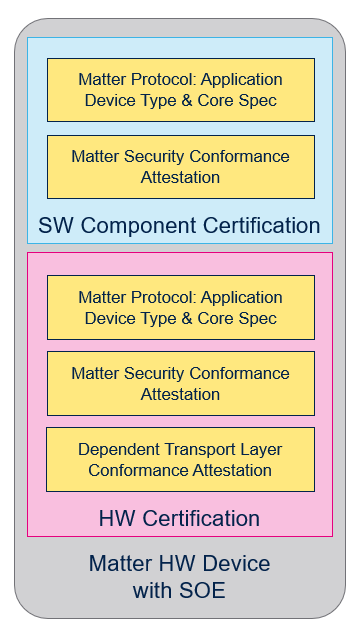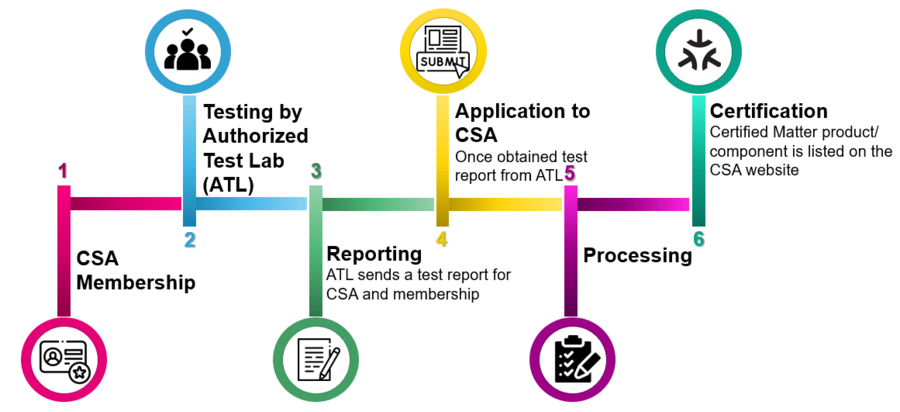1. Introduction
One of the key features of the Matter protocol is that its software code is open source, which means that anyone can develop devices that are compatible with it. However, to ensure that these devices are fully compliant with the Matter standard and support all of its security mechanisms, they must be certified by the Connectivity Standards Alliance (CSA).
The certification process involves testing and validation by a third-party testing lab to ensure that the device meets all the necessary hardware and software requirements for full compliance with the Matter standard. Only devices that have received official certification from the CSA are allowed to carry the Matter logo.
2. Matter certification types
CSA defines two types of certifications:
- Matter HW solution
- - Matter HW solution certification includes whole Matter SW and underlying transport layer (Thread/BLE, Wi-Fi, Ethernet)
- Matter SW component
- - Matter SW component certification only includes a subset of Matter HW solution and is only applicable to software components that run within the context of a supported operating environment (SOE).
SOE shall support, at minimum, all the mandatory requirements for a Matter software component.
3. Network interface layer certification
Matter protocol runs over various network interface technologies such as Thread, Wi-Fi, or Ethernet. To obtain Matter certification, devices must be certified according to these technologies. STMicroelectronics provides Matter over Thread end devices and Matter over ethernet bridge devices. Matter over Thread requires Bluetooth® LE for commissioning as per Matter standard. Matter SDK runs on top of a Thread/Bluetooth® LE dynamic concurrent mode protocol stack. As Matter hardware solution certification relies on dependent certification by dependent certification programs (DCP), to get Matter certification, the underlying network interface technologies must also be certified by related certification programs. This means that the certifications (or compliance testing) below are required for Matter end devices and Matter bridge devices.
- For Matter end devices:
- - Thread with Thread group (Thread certification process wiki article)
- - Bluetooth® LE (Bluetooth SIG)
- For Matter bridge devices:
- - Ethernet (ethernet compliance: showing evidence of successfully passing self-defined and self-testing of IEEE PMA (physical media attachment))
Note: Though the underlying network interface layer (e.g. Thread) must always be certified, change in this network interface layer does not imply to rerun Matter certification tests.
4. Matter certification process
Whatever the type of Matter certification (HW solution or SW component) , the process is the following :
- Become a member of the CSA
- Select an authorized test provider (ATL) and submit testing. The list of ATLs can be found on the CSA website.
- ATL delivers a final test report to the applicant and the CSA
- Submit certification application to the CSA
- CSA review application (Processing)
- CSA approves certification
- Public visibility of certified products on CSA website
- Matter certified logos
| Matter certification process |
|---|
5. Matter recertification process
There are today three types of recertification program: general, rapid and fast track recertifications.
5.1. General recertification
It is exactly similar to the initial full certification. It will be required in case of Matter related functionality changes on the device.
5.2. Rapid recertification program (RRP)
The rapid recertification program is only available to promoters and participants member companies, not available to adopters. It has been introduced by alliance to encourage qualified members, by making the process faster and less costly, to incorporate a newer version of the specification, SDK, stability fixes and/or test harness into their product having already obtained an original certification. Software updates not related to Matter code or Matter functionality are not addressed by this recertification program. For a device eligible to RRP (i.e. already certified and updated with permissible changes for this program), a qualified member needs to follow the steps below to recertify it by RRP:
STEP 1: Attend Alliance-approved training session at ATL or member meeting training program and register one or more point of contact (PoC) having satisfied the training requirements. A PoC can perform rapid recert testing, train other individuals within the same member company, sign-off rapid recert testing performed by these trained individuals
STEP 2: Test internally the updated product using the established alliance provided test suite to confirm protocol compliance
STEP 3: Share the test log with an ATL that will performs the checking of all test results
STEP 4: Apply for rapid recertification of updated product from the alliance with the declaration of conformity (DoC)
STEP 5: Alliance issues new certification for updated product
5.3. Fast track recertification program (FRP)
The fast track recertification program, specified by the alliance in November 2024, is only available to promoters and participants Member companies, not available to Adopters. Compared to RRP, the self-testing log is not shared with ATL but must be kept storage by the company for five years and two samples of the updated device must be sent to the alliance interop lab.
For a device eligible to FRP (i.e. already certified and updated with permissible changes for this program), you need to follow the steps below to recertify it by FRP:
STEP 1: Train Members of your development team to become qualified to use this program by attending formally approved Rapid Recert Training programs.
STEP 2: Test internally using the established alliance provided test suite. This will confirm protocol compliance.
STEP 3: Submit your documents to the alliance certification team.
STEP 4: Send two units to the alliance interoperability testing facility (interop lab). Alliance engineers will perform tests across operating systems and ecosystems to confirm that your product works in the real world. It is not necessary to wait for the completion of the interop testing. You are permitted to implement your s/w update on your product, and ship it/OTA upgrade to deployed devices, as soon as step 3 is completed. It’s important to note that while you don’t need to have tests run at an ATL, you need to run the tests internally and keep the logs for five years.
6. Test harness for Matter certification
As mentioned previously, the ATL runs the test harness for the specific candidate. The candidate also may conduct in-house testing to detect any possible issues that may arise during formal certification testing. This approach can be beneficial in terms of time and cost savings.
The list of tests requested by the CSA depends on the product to be certified. You can find all the necessary instructions and guidelines for CSA membership on their website.
To certify Dimmable Light device (STM32WB5MM-DK), with Matter SDK1.4, STMicroelectronics performed:
- 77 tests for Core including OTA and device discovery tests
- 43 tests for Clusters including On/Off, Level Control and Access Control clusters tests
7. Certification application documents for Matter
The four required documents for certification are:
- Declaration of Conformity (DoC)
- Protocol Implementation Conformance Statements (PICS), which is an XML file containing the mandatory and the optional functions supported by the product under certification. It can be generated using the CSA’s PICS tool.
- Dependent Certification Program (DCP) Attestation, which is an attestation confirming that you have obtained certification for the network interface technology being used for your Matter component. This attestation is required for technologies such as Bluetooth®, Thread, and Wi-Fi. The network transport attestation is not necessary for Matter SW component certification.
- Security attestation, which provides detailed information about the security level of the Matter component.
8. Acronyms and definitions
| Term | Definition |
|---|---|
| ATL | Authorized test lab |
| DoC | Declaration of conformity |
| FRP | Fast track recertification program |
| FTD | Full Thread device |
| MTD | Minimum Thread device |
| PICS | Protocol implementation conformance statements |
| RRP | Rapid recertification program |
| SOE | Supported operating environment |
| TCOC | Test and certification oversight committee |

